Adaptive Reuse for Sustainable Development and Land Use: A Multivariate Linear Regression Analysis Estimating Key Determinants of Public Perceptions
Abstract
1. Introduction
2. Review of the Adaptive Reuse Literature
3. Materials and Methods
3.1. The Iconic FIX Brewery Building Case as a Point of Reference
3.2. Survey
4. Results
4.1. Descriptive Statistical Analysis
4.2. Dependent Variable Creation
4.3. Multiple Linear Regression
5. Discussion and Conclusions
Funding
Institutional Review Board Statement
Informed Consent Statement
Data Availability Statement
Acknowledgments
Conflicts of Interest
References
- Vardopoulos, I. Industrial Building Adaptive Reuse for Museum. Factors Affecting Visitors’ Perceptions of the Sustainable Urban Development Potential. Build. Environ. 2022, 222, 109391. [Google Scholar] [CrossRef]
- Bottero, M.; D’Alpaos, C.; Oppio, A.; D’Alpaos, C.; Oppio, A. Ranking of Adaptive Reuse Strategies for Abandoned Industrial Heritage in Vulnerable Contexts: A Multiple Criteria Decision Aiding Approach. Sustainability 2019, 11, 785. [Google Scholar] [CrossRef]
- Vizzarri, C.; Sangiorgio, V.; Fatiguso, F.; Calderazzi, A. A Holistic Approach for the Adaptive Reuse Project Selection: The Case of the Former Enel Power Station in Bari. Land Use Policy 2021, 111, 105709. [Google Scholar] [CrossRef]
- Vardopoulos, I. Applied Urban Sustainability: Mixed Methods Research on Adaptive Reuse Practices: Studying the FIX Case. Ph.D. Thesis, Harokopio University, Kallithea, Greece, 2021. [Google Scholar]
- Chai, Q.; Li, H.; Tian, W.; Zhang, Y. Critical Success Factors for Safety Program Implementation of Regeneration of Abandoned Industrial Building Projects in China: A Fuzzy DEMATEL Approach. Sustainability 2022, 14, 1550. [Google Scholar] [CrossRef]
- Nikolić, M.; Drobnjak, B.; Kuletin Ćulafić, I. The Possibilities of Preservation, Regeneration and Presentation of Industrial Heritage: The Case of Old Mint “A.D.” on Belgrade Riverfront. Sustainability 2020, 12, 5264. [Google Scholar] [CrossRef]
- Zhang, J.; Cenci, J.; Becue, V.; Koutra, S. The Overview of the Conservation and Renewal of the Industrial Belgian Heritage as a Vector for Cultural Regeneration. Information 2021, 12, 27. [Google Scholar] [CrossRef]
- Tsilika, E.; Vardopoulos, I. The FIX-up Mix-up; Undue Facadism or Adaptive Reuse? Examining the Former FIX Brewery Transformation into the National Museum of Contemporary Art in Athens. ArchNet-IJAR 2022, 16, 688–709. [Google Scholar] [CrossRef]
- Săgeată, R.; Mitrică, B.; Mocanu, I. Centralized Industrialization in the Memory of Places. Case Studies of Romanian Cities. Societies 2021, 11, 132. [Google Scholar] [CrossRef]
- Kim, G.-E.; Lee, J.-R. The Impact of Historic Building Preservation in Urban Economics: Focusing on Accommodation Prices in Jeonju Hanok Village, South Korea. Sustainability 2020, 12, 5005. [Google Scholar] [CrossRef]
- Foster, G.; Saleh, R. The Adaptive Reuse of Cultural Heritage in European Circular City Plans: A Systematic Review. Sustainability 2021, 13, 2889. [Google Scholar] [CrossRef]
- Vinci, S.; Vardopoulos, I.; Salvati, L. A Tale of a Shrinking City? Exploring the Complex Interplay of Socio-Demographic Dynamics in the Recent Development of Attica, Greece. Cities 2023, 132, 104089. [Google Scholar] [CrossRef]
- Ciommi, M.; Egidi, G.; Vardopoulos, I.; Chelli, F.M.; Salvati, L. Toward a ‘Migrant Trap’? Local Development, Urban Sustainability, Sociodemographic Inequalities, and the Economic Decline in a Mediterranean Metropolis. Soc. Sci. 2022, 12, 26. [Google Scholar] [CrossRef]
- Alaimo, L.S.; Ciommi, M.; Vardopoulos, I.; Nosova, B.; Salvati, L. The Medium-Term Impact of the COVID-19 Pandemic on Population Dynamics: The Case of Italy. Sustainability 2022, 14, 13995. [Google Scholar] [CrossRef]
- Kempton, Y.; Salvati, L.; Vardopoulos, I. Long-Term Planning and Development for Urban and Regional Inclusion, Safety, Resilience, and Sustainability. Insights from Singapore. Reg. Peripher. 2022, 14, 59–79. [Google Scholar] [CrossRef]
- Efstathiou, K.; Papamattheakis, G.; Tryfonopoulos, S. The Fate of Unbaptized Buildings: A Theology for Preservation. In AMPS Proceedings Series 15, Proceedings of the Tangible—Intangible Heritage(s)—Design, Social and Cultural Critiques on the Past, the Present and the Future, London, UK, 13–15 June 2018; Issue 2; UCL Press: London, UK, 2018; pp. 242–247. [Google Scholar]
- Sowińska-Heim, J. Adaptive Reuse of Architectural Heritage and Its Role in the Post-Disaster Reconstruction of Urban Identity: Post-Communist Łódź. Sustainability 2020, 12, 8054. [Google Scholar] [CrossRef]
- Lin, S.-H.; Huang, X.; Fu, G.; Chen, J.-T.; Zhao, X.; Li, J.-H.; Tzeng, G.-H. Evaluating the Sustainability of Urban Renewal Projects Based on a Model of Hybrid Multiple-Attribute Decision-Making. Land Use Policy 2021, 108, 105570. [Google Scholar] [CrossRef]
- Vardopoulos, I.; Stamopoulos, C.; Chatzithanasis, G.; Michalakelis, C.; Giannouli, P.; Pastrapa, E. Considering Urban Development Paths and Processes on Account of Adaptive Reuse Projects. Buildings 2020, 10, 73. [Google Scholar] [CrossRef]
- Al-Obaidi, K.; Wei, S.; Ismail, M.; Kam, K. Sustainable Building Assessment of Colonial Shophouses after Adaptive Reuse in Kuala Lumpur. Buildings 2017, 7, 87. [Google Scholar] [CrossRef]
- De Medici, S.; De Toro, P.; Nocca, F. Cultural Heritage and Sustainable Development: Impact Assessment of Two Adaptive Reuse Projects in Siracusa, Sicily. Sustainability 2019, 12, 311. [Google Scholar] [CrossRef]
- Karametou, P.; Mitoula, R.; Papavasileiou, A. The Social Impact of Ellinikon Renovation Project: The Athenians Citizen’s Perception. In Proceedings of the CHANGING CITIES V: Spatial, Design, Landscape, Heritage and Socio-Economic Dimensions, Corfu, Greece, 20–25 June 2022. [Google Scholar]
- Skayannis, P. Mega Infrastructure Projects in Greece after Its Accession to the EU (1981–2021). Reg. Peripher. 2021, 12, 41–63. [Google Scholar] [CrossRef]
- Guo, P.; Li, Q.; Guo, H.; Li, H. Quantifying the Core Driving Force for the Sustainable Redevelopment of Industrial Heritage: Implications for Urban Renewal. Environ. Sci. Pollut. Res. 2021, 28, 48097–48111. [Google Scholar] [CrossRef] [PubMed]
- Tan, Y.; Shen, L.; Langston, C. A Fuzzy Approach for Adaptive Reuse Selection of Industrial Buildings in Hong Kong. Int. J. Strateg. Prop. Manag. 2014, 18, 66–76. [Google Scholar] [CrossRef]
- Zhang, S. Conservation and Adaptive Reuse of Industrial Heritage in Shanghai. Front. Archit. Civ. Eng. China 2007, 1, 481–490. [Google Scholar] [CrossRef]
- ODASA Design Guidance Note: Adaptive Re-Use. Re-Using Existing Buildings for New Functions Has Many Sustainable, Cultural, Economic and Placemaking Advantages. 2014. Available online: https://cdn.environment.sa.gov.au/environment/docs/her-conservation-adaptive-reuse-guide-odasa.pdf (accessed on 10 December 2022).
- Wang, M.; Yang, J. Sustainable Renewal of Historical Urban Areas: A Demand–Potential–Constraint Model for Identifying the Renewal Type of Residential Buildings. Buildings 2022, 12, 1210. [Google Scholar] [CrossRef]
- Boussaa, D. Urban Regeneration and the Search for Identity in Historic Cities. Sustainability 2017, 10, 48. [Google Scholar] [CrossRef]
- Stefanou, J.; Mitoula, R. The Phenomenon of Globalization and Its Urban Expressions—Globalization and the Physiognomy of Cities. In The Identities of the New Urban Reality, Articulations Urban Forms and Social Fate; Ecole Nationale Supérieure d’Architecture de Paris La Villette, Università Degli Studi di Napoli Federico II: Naples, Italy, 2005; pp. 23–39. [Google Scholar]
- Stefanou, J.; Mitoula, R. Urban Planning in Hermoupolis—A New View on the Conservation and Enhancement of Historic Settlements. Hous. Build. Res. Cent. Int. J. 2005, 1, 113. [Google Scholar]
- Vythoulka, A.; Delegou, E.T.; Caradimas, C.; Moropoulou, A. Protection and Revealing of Traditional Settlements and Cultural Assets, as a Tool for Sustainable Development: The Case of Kythera Island in Greece. Land 2021, 10, 1324. [Google Scholar] [CrossRef]
- De Gregorio, S.; De Vita, M.; De Berardinis, P.; Palmero, L.; Risdonne, A. Designing the Sustainable Adaptive Reuse of Industrial Heritage to Enhance the Local Context. Sustainability 2020, 12, 9059. [Google Scholar] [CrossRef]
- Fava, F. Commoning Adaptive Heritage Reuse as a Driver of Social Innovation: Naples and the Scugnizzo Liberato Case Study. Sustainability 2021, 14, 191. [Google Scholar] [CrossRef]
- Vardopoulos, I.; Theodoropoulou, E. Does the New ‘FIX’ Fit? Adaptive Building Reuse Affecting Local Sustainable Development: Preliminary Results. In Proceedings of the The IAFOR Conference on Heritage & the City (HCNY2018), New York, NY, USA, 7–9 November 2018. [Google Scholar]
- Yuan, H.; Wang, Z.; Shi, Y.; Hao, J. A Dissipative Structure Theory-Based Investigation of a Construction and Demolition Waste Minimization System in China. J. Environ. Plan. Manag. 2022, 65, 514–535. [Google Scholar] [CrossRef]
- Zhao, X.; Webber, R.; Kalutara, P.; Browne, W.; Pienaar, J. Construction and Demolition Waste Management in Australia: A Mini-Review. Waste Manag. Res. J. A Sustain. Circ. Econ. 2022, 40, 34–46. [Google Scholar] [CrossRef]
- Vardopoulos, I.; Theodoropoulou, E. Adaptive Reuse: An Essential Circular Economy Concept. Urban. Inf. 2020, 289, 4–6. [Google Scholar]
- Ikiz Kaya, D.; Pintossi, N.; Dane, G. An Empirical Analysis of Driving Factors and Policy Enablers of Heritage Adaptive Reuse within the Circular Economy Framework. Sustainability 2021, 13, 2479. [Google Scholar] [CrossRef]
- Marika, G.; Beatrice, M.; Francesca, A. Adaptive Reuse and Sustainability Protocols in Italy: Relationship with Circular Economy. Sustainability 2021, 13, 8077. [Google Scholar] [CrossRef]
- Acri, M.; Dobričić, S.; Debevec, M. Regenerating the Historic Urban Landscape through Circular Bottom-Up Actions: The Urban Seeding Process in Rijeka. Sustainability 2021, 13, 4497. [Google Scholar] [CrossRef]
- Bosone, M.; De Toro, P.; Fusco Girard, L.; Gravagnuolo, A.; Iodice, S. Indicators for Ex-Post Evaluation of Cultural Heritage Adaptive Reuse Impacts in the Perspective of the Circular Economy. Sustainability 2021, 13, 4759. [Google Scholar] [CrossRef]
- Fusco Girard, L.; Vecco, M. The “Intrinsic Value” of Cultural Heritage as Driver for Circular Human-Centered Adaptive Reuse. Sustainability 2021, 13, 3231. [Google Scholar] [CrossRef]
- Gravagnuolo, A.; Micheletti, S.; Bosone, M. A Participatory Approach for “Circular” Adaptive Reuse of Cultural Heritage. Building a Heritage Community in Salerno, Italy. Sustainability 2021, 13, 4812. [Google Scholar] [CrossRef]
- Gravagnuolo, A.; Varotto, M. Terraced Landscapes Regeneration in the Perspective of the Circular Economy. Sustainability 2021, 13, 4347. [Google Scholar] [CrossRef]
- Stanojev, J.; Gustafsson, C. Smart Specialisation Strategies for Elevating Integration of Cultural Heritage into Circular Economy. Sustainability 2021, 13, 3685. [Google Scholar] [CrossRef]
- Szemző, H.; Mosquera, J.; Polyák, L.; Hayes, L. Flexibility and Adaptation: Creating a Strategy for Resilience. Sustainability 2022, 14, 2688. [Google Scholar] [CrossRef]
- Mieg, H.A. Social Innovation in Sustainable Urban Development. Sustainability 2022, 14, 5414. [Google Scholar] [CrossRef]
- Lanz, F. The Adaptive Reuse of Neglected Buildings. In Contested Spaces, Concerted Projects—Designs for Vulnerable Memories; Colombo, C., Leveratto, J., Eds.; Lettera Ventidue: Siracuse, Italy, 2022; pp. 68–85. ISBN 9788862424837. [Google Scholar]
- Boulanger, S.O.M.; Longo, D.; Roversi, R. Data Evidence-Based Transformative Actions in Historic Urban Context—The Bologna University Area Case Study. Smart Cities 2020, 3, 1448–1476. [Google Scholar] [CrossRef]
- Dane, G.; Borgers, A.; Kaya, D.I.; Feng, T. Visitor Flows at a Large-Scale Cultural Event: GPS Tracking at Dutch Design Week. ISPRS Int. J. Geo-Inf. 2020, 9, 661. [Google Scholar] [CrossRef]
- Dane, G.; Borgers, A.; Feng, T. Subjective Immediate Experiences during Large-Scale Cultural Events in Cities: A Geotagging Experiment. Sustainability 2019, 11, 5698. [Google Scholar] [CrossRef]
- Weijs-Perrée, M.; Dane, G.; van den Berg, P. Analyzing the Relationships between Citizens’ Emotions and Their Momentary Satisfaction in Urban Public Spaces. Sustainability 2020, 12, 7921. [Google Scholar] [CrossRef]
- Owojori, O.; Okoro, C.; Chileshe, N. Current Status and Emerging Trends on the Adaptive Reuse of Buildings: A Bibliometric Analysis. Sustainability 2021, 13, 11646. [Google Scholar] [CrossRef]
- Bullen, P.A. Adaptive Reuse and Sustainability of Commercial Buildings. Facilities 2007, 25, 20–31. [Google Scholar] [CrossRef]
- Plevoets, B.; Van Cleempoel, K. Adaptive Reuse as a Strategy towards Conservation of Cultural Heritage: A Literature Review. Struct. Repairs Maint. Herit. Archit. 2011, 118, 155–164. [Google Scholar]
- Stepanchuk, A.; Gafurova, S.; Latypova, M. «Genius Loci» as a Resource for the Development of Historical Areas of the City. IOP Conf. Ser. Mater. Sci. Eng. 2020, 890, 012013. [Google Scholar] [CrossRef]
- Bullen, P.A.; Love, P.E.D. Residential Regeneration and Adaptive Reuse: Learning from the Experiences of Los Angeles. Struct. Surv. 2009, 27, 351–360. [Google Scholar] [CrossRef]
- Conejos, S.; Langston, C.; Chan, E.H.W.; Chew, M.Y.L. Governance of Heritage Buildings: Australian Regulatory Barriers to Adaptive Reuse. Build. Res. Inf. 2016, 44, 507–519. [Google Scholar] [CrossRef]
- Yung, E.H.K.; Langston, C.; Chan, E.H.W. Adaptive Reuse of Traditional Chinese Shophouses in Government-Led Urban Renewal Projects in Hong Kong. Cities 2014, 39, 87–98. [Google Scholar] [CrossRef]
- Mohamed, R.; Boyle, R.; Yang, A.Y.; Tangari, J. Adaptive Reuse: A Review and Analysis of Its Relationship to the 3 Es of Sustainability. Facilities 2017, 35, 138–154. [Google Scholar] [CrossRef]
- Eyüce, Ö.; Eyüce, A. Design Education for Adaptive Reuse. Archnet-IJAR 2010, 4, 419–428. [Google Scholar]
- Pourzargar, M. Posto-Corona Visioning for Sustainable Adaptive Reuse of Kahrzak Sugar Factory. Naqshejahan 2022, 11, 79–95. [Google Scholar]
- Mitoula, R.; Theodoropoulou, E.; Karali, B. Sustainable Development in the City of Volos through Reuse of Industrial Buildings. Sustain. Dev. Cult. Tradit. J. 2013, 2, 154–167. [Google Scholar] [CrossRef]
- Jamhawi, M.; Mubaideen, S.; Mahamid, B. Industrial Heritage: Towards a Sustainable Adaptive Reuse of Wheat Milling Heritage Buildings in Jordan. J. Cult. Herit. Manag. Sustain. Dev. 2021. [Google Scholar] [CrossRef]
- van Knippenberg, K.; Boonstra, B. Co-Evolutionary Heritage Reuse: A European Multiple Case Study Perspective. Eur. Plan. Stud. 2021, 1–18. [Google Scholar] [CrossRef]
- Grigorescu, I.; Dumitrică, C.; Dumitrașcu, M.; Mitrică, B.; Dumitrașcu, C. Urban Development and the (Re)Use of the Communist-Built Industrial and Agricultural Sites after 1990. The Showcase of Bucharest–Ilfov Development Region. Land 2021, 10, 1044. [Google Scholar] [CrossRef]
- Misirlisoy, D.; Günçe, K. A Critical Look to the Adaptive Reuse of Traditional Urban Houses in the Walled City of Nicosia. J. Archit. Conserv. 2016, 22, 149–166. [Google Scholar] [CrossRef]
- Plevoets, B.; Van Cleempoel, K. Aemulatio and the Interior Approach of Adaptive Reuse. Interiors 2014, 5, 71–88. [Google Scholar] [CrossRef]
- Celadyn, M. Interior Architectural Design for Adaptive Reuse in Application of Environmental Sustainability Principles. Sustainability 2019, 11, 3820. [Google Scholar] [CrossRef]
- Langston, C.; Shen, L.-Y. Application of the Adaptive Reuse Potential Model in Hong Kong: A Case Study of Lui Seng Chun. Int. J. Strateg. Prop. Manag. 2007, 11, 193–207. [Google Scholar] [CrossRef]
- Allahaim, F.; Alfaris, A.; Leifer, D. Towards Changeability: The Adaptable Buildings Design (ABD) Framework. In Proceedings of the 5th International Conference of Arab Society for Computer Aided Architectural Design, Fès, Morocco, 19 October 2010. [Google Scholar]
- Conejos, S.; Langston, C.; Smith, J. AdaptSTAR Model: A Climate-Friendly Strategy to Promote Built Environment Sustainability. Habitat Int. 2013, 37, 95–103. [Google Scholar] [CrossRef]
- Langston, C.; Smith, J. Modelling Property Management Decisions Using ‘IconCUR. ’ Autom. Constr. 2012, 22, 406–413. [Google Scholar] [CrossRef]
- Gosling, J.; Sassi, P.; Naim, M.; Lark, R. Adaptable Buildings: A Systems Approach. Sustain. Cities Soc. 2013, 7, 44–51. [Google Scholar] [CrossRef]
- Wilkinson, S.J. The Preliminary Assessment of Adaptation Potential in Existing Office Buildings. Int. J. Strateg. Prop. Manag. 2014, 18, 77–87. [Google Scholar] [CrossRef]
- McArthur, J.J.; Jofeh, C.G.H. Portfolio Retrofit Evaluation: A Methodology for Optimizing a Large Number of Building Retrofits to Achieve Triple-Bottom-Line Objectives. Sustain. Cities Soc. 2016, 27, 263–274. [Google Scholar] [CrossRef]
- Ross, B.E. The Learning Buildings Framework for Quantifying Building Adaptability. In Proceedings of the ASCE Architectural Engineering Institute Conference, Oklahoma City, OK, USA, 11–13 April 2017. [Google Scholar]
- Zheng, X.; Heath, T.; Guo, S. From Maslow to Architectural Spaces: The Assessment of Reusing Old Industrial Buildings. Buildings 2022, 12, 2033. [Google Scholar] [CrossRef]
- Langston, C. Validation of the Adaptive Reuse Potential (ARP) Model Using IconCUR. Facilities 2012, 30, 105–123. [Google Scholar] [CrossRef]
- Conejos, S.; Langston, C.; Smith, J. Enhancing Sustainability through Designing for Adaptive Reuse from the Outset: A Comparison of Adaptstar and Adaptive Reuse Potential (ARP) Models. Facilities 2015, 33, 531–552. [Google Scholar] [CrossRef]
- Vardopoulos, I. Multi-Criteria Analysis for Energy Independence from Renewable Energy Sources Case Study Zakynthos Island, Greece. Int. J. Environ. Sci. Dev. 2017, 8, 460–465. [Google Scholar] [CrossRef]
- Zorpas, A.A.; Phinikettou, V.; Voukkali, I. Proposed Rehabilitation Method of Uncontrolled Landfills in Insular Communities Through Multi-Criteria Analysis Decision Tool. In Phytoremediation; Springer: Cham, Switzerland, 2016; pp. 365–383. [Google Scholar]
- Aigwi, I.E.; Egbelakin, T.; Ingham, J.; Phipps, R.; Rotimi, J.; Filippova, O. A Performance-Based Framework to Prioritise Underutilised Historical Buildings for Adaptive Reuse Interventions in New Zealand. Sustain. Cities Soc. 2019, 48, 101547. [Google Scholar] [CrossRef]
- Chen, C.S.; Chiu, Y.H.; Tsai, L. Evaluating the Adaptive Reuse of Historic Buildings through Multicriteria Decision-Making. Habitat Int. 2018, 81, 12–23. [Google Scholar] [CrossRef]
- Hsu, Y.-H.; Juan, Y.-K. ANN-Based Decision Model for the Reuse of Vacant Buildings in Urban Areas. Int. J. Strateg. Prop. Manag. 2016, 20, 31–43. [Google Scholar] [CrossRef]
- Tan, Y.; Shen, L.; Langston, C.; Liu, Y. Construction Project Selection Using Fuzzy TOPSIS Approach. J. Model. Manag. 2010, 5, 302–315. [Google Scholar] [CrossRef]
- Abastante, F.; Lami, I.M.; Mecca, B. How to Revitalise a Historic District: A Stakeholders-Oriented Assessment Framework of Adaptive Reuse. In Values and Functions for Future Cities. Green Energy and Technology; Mondini, G., Oppio, A., Stanghellini, S., Bottero, M., Abastante, F., Eds.; Springer: Cham, Switzerland, 2020; pp. 3–20. [Google Scholar]
- Della Spina, L. Cultural Heritage: A Hybrid Framework for Ranking Adaptive Reuse Strategies. Buildings 2021, 11, 132. [Google Scholar] [CrossRef]
- Vardopoulos, I. Critical Sustainable Development Factors in the Adaptive Reuse of Urban Industrial Buildings. A Fuzzy DEMATEL Approach. Sustain. Cities Soc. 2019, 50, 101684. [Google Scholar] [CrossRef]
- Milošević, D.M.; Milošević, M.R.; Simjanović, D.J. Implementation of Adjusted Fuzzy AHP Method in the Assessment for Reuse of Industrial Buildings. Mathematics 2020, 8, 1697. [Google Scholar] [CrossRef]
- Vardopoulos, I.; Tsilika, E.; Sarantakou, E.; Zorpas, A.; Salvati, L.; Tsartas, P. An Integrated SWOT-PESTLE-AHP Model Assessing Sustainability in Adaptive Reuse Projects. Appl. Sci. 2021, 11, 7134. [Google Scholar] [CrossRef]
- Akinade, O.O.; Oyedele, L.O.; Bilal, M.; Ajayi, S.O.; Owolabi, H.A.; Alaka, H.A.; Bello, S.A. Waste Minimisation through Deconstruction: A BIM Based Deconstructability Assessment Score (BIM-DAS). Resour. Conserv. Recycl. 2015, 105, 167–176. [Google Scholar] [CrossRef]
- Sanchez, B.; Rausch, C.; Haas, C. “Deconstruction Programming for Adaptive Reuse of Buildings. Autom. Constr. 2019, 107, 102921. [Google Scholar] [CrossRef]
- Sanchez, B.; Rausch, C.; Haas, C.; Saari, R. A Selective Disassembly Multi-Objective Optimization Approach for Adaptive Reuse of Building Components. Resour. Conserv. Recycl. 2020, 154, 104605. [Google Scholar] [CrossRef]
- Sanchez, B.; Haas, C. A Novel Selective Disassembly Sequence Planning Method for Adaptive Reuse of Buildings. J. Clean. Prod. 2018, 183, 998–1010. [Google Scholar] [CrossRef]
- Anelli, D.; Tajani, F. Valorization of Cultural Heritage and Land Take Reduction: An Urban Compensation Model for the Replacement of Unsuitable Buildings in an Italian UNESCO Site. J. Cult. Herit. 2022, 57, 165–172. [Google Scholar] [CrossRef]
- Aksözen, M.; Hassler, U.; Rivallain, M.; Kohler, N. Mortality Analysis of an Urban Building Stock. Build. Res. Inf. 2017, 45, 259–277. [Google Scholar] [CrossRef]
- Erik Bradley, P.; Kohler, N. Methodology for the Survival Analysis of Urban Building Stocks. Build. Res. Inf. 2007, 35, 529–542. [Google Scholar] [CrossRef]
- Liu, G.; Xu, K.; Zhang, X.; Zhang, G. Factors Influencing the Service Lifespan of Buildings: An Improved Hedonic Model. Habitat Int. 2014, 43, 274–282. [Google Scholar] [CrossRef]
- Boschmann, E.E.; Gabriel, J.N. Urban Sustainability and the LEED Rating System: Case Studies on the Role of Regional Characteristics and Adaptive Reuse in Green Building in Denver and Boulder, Colorado. Geogr. J. 2013, 179, 221–233. [Google Scholar] [CrossRef]
- Dewiyana, E.; Ibrahim, N.; Hajar, N.H. The Green Aspects of Adaptive Reuse of Hotel Penaga. Procedia-Soc. Behav. Sci. 2016, 222, 631–643. [Google Scholar] [CrossRef]
- Wilkinson, S.J.; Osmond, P. Building Resilience in Urban Settlements. Int. J. Build. Pathol. Adapt. 2018, 36, 334–336. [Google Scholar] [CrossRef]
- Aytac, D.O.; Arslan, T.V.; Durak, S. Adaptive Reuse as a Strategy toward Urban Resilience. Eur. J. Sustain. Dev. 2016, 5, 523–532. [Google Scholar] [CrossRef]
- Eray, E.; Sanchez, B.; Haas, C. Usage of Interface Management System in Adaptive Reuse of Buildings. Buildings 2019, 9, 105. [Google Scholar] [CrossRef]
- McKenna, H.P. Adaptive Reuse of Cultural Heritage Elements and Fragments in Public Spaces: The Internet of Cultural Things and Applications as Infrastructures for Learning in Smart Cities. In Proceedings of the 2017 13th International Conference on Signal-Image Technology & Internet-Based Systems (SITIS), Jaipur, India, 4–7 December 2017; pp. 479–484. [Google Scholar]
- Armstrong, G.; Soebarto, V.; Zuo, J. Vacancy Visual Analytics Method: Evaluating Adaptive Reuse as an Urban Regeneration Strategy through Understanding Vacancy. Cities 2021, 115, 103220. [Google Scholar] [CrossRef]
- Hamida, M.B.; Hassanain, M.A. A Framework Model for AEC/FM Knowledge in Adaptive Reuse Projects. J. Eng. Des. Technol. 2022, 20, 624–648. [Google Scholar] [CrossRef]
- Yazdani Mehr, S.; Wilkinson, S.J. Technical Issues and Energy Efficient Adaptive Reuse of Heritage Listed City Halls in Queensland Australia. Int. J. Build. Pathol. Adapt. 2018, 36, 529–542. [Google Scholar] [CrossRef]
- Aksamija, A. Regenerative Design and Adaptive Reuse of Existing Commercial Buildings for Net-Zero Energy Use. Sustain. Cities Soc. 2016, 27, 185–195. [Google Scholar] [CrossRef]
- Breçani, R.; Dervishi, S. Thermal and Energy Performance Evaluation of Underground Bunkers: An Adaptive Reuse Approach. Sustain. Cities Soc. 2019, 46, 101444. [Google Scholar] [CrossRef]
- Hegazi, Y.S.; Shalaby, H.A.; Mohamed, M.A.A. Adaptive Reuse Decisions for Historic Buildings in Relation to Energy Efficiency and Thermal Comfort—Cairo Citadel, a Case Study from Egypt. Sustainability 2021, 13, 10531. [Google Scholar] [CrossRef]
- Tan, Y.; Shuai, C.; Wang, T. Critical Success Factors (CSFs) for the Adaptive Reuse of Industrial Buildings in Hong Kong. Int. J. Environ. Res. Public Health 2018, 15, 1546. [Google Scholar] [CrossRef] [PubMed]
- Günçe, K.; Misirlisoy, D. Assessment of Adaptive Reuse Practices through User Experiences: Traditional Houses in Thewalled City of Nicosia. Sustainability 2019, 11, 540. [Google Scholar] [CrossRef]
- Aigwi, I.E.; Phipps, R.; Ingham, J.; Filippova, O. Characterisation of Adaptive Reuse Stakeholders and the Effectiveness of Collaborative Rationality towards Building Resilient Urban Areas. Syst. Pract. Action Res. 2021, 34, 141–151. [Google Scholar] [CrossRef]
- Yung, E.H.K.; Chan, E.H.W.; Xu, Y. Community-Initiated Adaptive Reuse of Historic Buildings and Sustainable Development in the Inner City of Shanghai. J. Urban Plan. Dev. 2014, 140, 05014003. [Google Scholar] [CrossRef]
- Glumac, B.; Islam, N. Housing Preferences for Adaptive Re-Use of Office and Industrial Buildings: Demand Side. Sustain. Cities Soc. 2020, 62, 102379. [Google Scholar] [CrossRef]
- Rosenbaum, M.S.; Kim, K.; Ramirez, G.C.; Orejuela, A.R.; Park, J. Improving Well-Being via Adaptive Reuse: Transformative Repurposed Service Organizations. Serv. Ind. J. 2021, 41, 223–247. [Google Scholar] [CrossRef]
- Santucci, L.; Cassalia, G.; Calabrò, F. Economic Feasibility of a Project for the Reuse of the Old Hospital of Nicotera as a Center for Eating Disorders and for the Enhancement of the Mediterranean Diet. In Proceedings of the International Symposium New Metropolian Perspectives—Post COVID Dynamics: Green and Digital Transition, between Metropolitan and Return to Villages Perspectives, Reggio Calabria, Italy, 24–26 May 2022; Springer: Cham, Switzerland, 2022; pp. 2347–2360. [Google Scholar]
- Cortesi, A.; Vardopoulos, I.; Salvati, L. A Partial Least Squares Analysis of the Perceived Impact of Sustainable Real Estate Design upon Wellbeing. Urban Sci. 2022, 6, 69. [Google Scholar] [CrossRef]
- Chymis, A. Wellbeing, Productivity and Competitiveness at a Regional Level: The Role of Institutions. Reg. Peripher. 2019, 8, 143–164. [Google Scholar] [CrossRef]
- Md Ali, Z.; Zawawi, R.; Myeda, N.E.; Mohamad, N. Adaptive Reuse of Historical Buildings. Int. J. Build. Pathol. Adapt. 2019, 37, 54–68. [Google Scholar] [CrossRef]
- Elshaer, I.A.; Fayyad, S.; Ammar, S.; Abdulaziz, T.A.; Mahmoud, S.W. Adaptive Reuse of Heritage Houses and Hotel Conative Loyalty: Digital Technology as a Moderator and Memorable Tourism and Hospitality Experience as a Mediator. Sustainability 2022, 14, 3580. [Google Scholar] [CrossRef]
- Vardopoulos, I.; Theodoropoulou, E. Theoretical Considerations and Pilot Findings on the Adaptive Reuse Potential for Tourism and Sustainable Urban Development. In Proceedings of the 3rd International Scientific Conference TOURMAN 2019, Thessaloniki, Greece, 24–27 October 2019; International Hellenic University: Thessaloniki, Greece, 2019; pp. 374–376. [Google Scholar]
- He, X.; Zang, T.; Zhou, T.; Ikebe, K. Historic Conservation and Tourism Economy: Challenges Facing Adaptive Reuse of Historic Conservation Areas in Chengdu, China. Conservation 2022, 2, 485–498. [Google Scholar] [CrossRef]
- Manola, M. Contribution of the Venetian Monuments of Rhodes to Cultural Tourism and the Local Development of the Island. Open J. Res. Econ. 2022, 5, 35–42. [Google Scholar] [CrossRef]
- Yin, R. Case Study Research: Design and Methods; SAGE: Thousand Oaks, CA, USA, 2013; ISBN 9781452242569. [Google Scholar]
- Ragazou, K.; Passas, I.; Garefalakis, A.; Zafeiriou, E.; Kyriakopoulos, G. The Determinants of the Environmental Performance of EU Financial Institutions: An Empirical Study with a GLM Model. Energies 2022, 15, 5325. [Google Scholar] [CrossRef]
- Charitonidou, M. Takis Zenetos’s Electronic Urbanism and Tele-Activities: Minimizing Transportation as Social Aspiration. Urban Sci. 2021, 5, 31. [Google Scholar] [CrossRef]
- Vardopoulos, I. Enduring Remnants from the Urban Industrial Past. Urban. Archit. Constr. 2021, 12, 73–74. [Google Scholar]
- Zenetos, T.; Apostolidis, M. A Brewery in Athens. Architects: T. Ch. Zenetos—M. Ch. Apostilidis. Architektoniki 1963, Z’, 10–16. [Google Scholar]
- Theodoropoulou, D. ΦΙΞFIX 120+ Years of Architecture: Takis Zenetos—Margaritis Apostolidis, a Turning Point in the History of the FIX Building; Epikentro: Athens, Greece, 2020. [Google Scholar]
- Gago, J.; Anastácio, P.; Gkenas, C.; Banha, F.; Ribeiro, F. Spatial Distribution Patterns of the Non-Native European Catfish, Silurus Glanis, from Multiple Online Sources—A Case Study for the River Tagus (Iberian Peninsula). Fish. Manag. Ecol. 2016, 23, 503–509. [Google Scholar] [CrossRef]
- Heikinheimo, V.; Minin, E.D.; Tenkanen, H.; Hausmann, A.; Erkkonen, J.; Toivonen, T. User-Generated Geographic Information for Visitor Monitoring in a National Park: A Comparison of Social Media Data and Visitor Survey. ISPRS Int. J. Geo-Inf. 2017, 6, 85. [Google Scholar] [CrossRef]
- Oppenheim, A.N. Questionnaire Design, Interviewing, and Attitude Measurement; Bloomsbury Academic: London, UK, 1992; ISBN 0826451764. [Google Scholar]
- Arsenos, P.; Charamis, D.; Garefalakis, A. Pricing of Brand Extensions Based on Perceptions of Brand Equity. J. Gov. Regul. 2018, 7, 15–21. [Google Scholar] [CrossRef]
- Alias, A.; Zyed, Z.; Chai, W.W. Revitalising Critical Components of Urban Decay Features. J. Build. Perform. 2016, 7, 125–132. [Google Scholar]
- Berrens, R.; Bohara, A.; Jenkins-Smith, H.; Silva, C.; Weimer, D. The Advent of Internet Surveys for Political Research: A Comparison of Telephone and Internet Samples. Polit. Anal. 2003, 11, 1–22. [Google Scholar] [CrossRef]
- Garefalakis, A.; Dimitras, A. Looking Back and Forging Ahead: The Weighting of ESG Factors. Ann. Oper. Res. 2020, 294, 151–189. [Google Scholar] [CrossRef]
- Karytsas, S.; Vardopoulos, I.; Theodoropoulou, E. Factors Affecting Residents’ Attitude toward Sustainable Tourism Development. Tourismos 2019, 14, 1–40. [Google Scholar] [CrossRef]
- Karytsas, S.; Vardopoulos, I.; Theodoropoulou, E. Factors Affecting Sustainable Market Acceptance of Residential Microgeneration Technologies. A Two Time Period Comparative Analysis. Energies 2019, 12, 3298. [Google Scholar] [CrossRef]
- Eurostat Mean and Median Income by Household Type—EU-SILC and ECHP Surveys (Ilc_di04). 2020. Available online: https://data.europa.eu/data/datasets/kl0oijpz1d1aagzfj1h3fa?locale=en (accessed on 10 December 2022).
- Cabrera-Nguyen, P. Author Guidelines for Reporting Scale Development and Validation Results in the Journal of the Society for Social Work and Research. J. Soc. Soc. Work Res. 2010, 1, 99–103. [Google Scholar] [CrossRef]
- Worthington, R.L.; Whittaker, T.A. Scale Development Research. Couns. Psychol. 2006, 34, 806–838. [Google Scholar] [CrossRef]
- Taecharungroj, V.; Tachapattaworakul Suksaroj, T.; Rattanapan, C. The Place Sustainability Scale: Measuring Residents’ Perceptions of the Sustainability of a Town. J. Place Manag. Dev. 2018, 11, 370–390. [Google Scholar] [CrossRef]
- Dassen, T.; Kunseler, E.; van Kessenich, L.M. The Sustainable City: An Analytical-Deliberative Approach to Assess Policy in the Context of Sustainable Urban Development. Sustain. Dev. 2013, 21, 193–205. [Google Scholar] [CrossRef]
- Shen, L.-Y.; Jorge Ochoa, J.; Shah, M.N.; Zhang, X. The Application of Urban Sustainability Indicators—A Comparison between Various Practices. Habitat Int. 2011, 35, 17–29. [Google Scholar] [CrossRef]
- Salvati, L.; Carlucci, M. A Composite Index of Sustainable Development at the Local Scale: Italy as a Case Study. Ecol. Indic. 2014, 43, 162–171. [Google Scholar] [CrossRef]
- Egger, S. Determining a Sustainable City Model. Environ. Model. Softw. 2006, 21, 1235–1246. [Google Scholar] [CrossRef]
- Kenworthy, J.R. The Eco-City: Ten Key Transport and Planning Dimensions for Sustainable City Development. Environ. Urban. 2006, 18, 67–85. [Google Scholar] [CrossRef]
- Berardi, U. Beyond Sustainability Assessment Systems: Upgrading Topics by Enlarging The Scale of Assessment. Int. J. Sustain. Build. Technol. Urban Dev. 2011, 2, 276–282. [Google Scholar] [CrossRef]
- Suridechakul, W. Factors Affecting Sustainable Community Development: A Case Study of Dusit District Community. In Proceedings of the Recent Advances on Energy, Environment, Ecosystems, and Development. Proceedings of the International Conference on Energy, Environment, Ecosystems, and Development (EEED 2015), Barcelona, Spain, 7–9 April 2015; pp. 106–110. [Google Scholar]
- Lemonakis, C.; Garefalakis, A.; Xanthos, G.; Sialveras, N. Principle Characteristics in Firms’ Competitiveness Endeavour: Use of Managerial and Strategic Reasoning Technics for (SMEs). Int. J. Supply Chain Manag. 2019, 8, 119–125. [Google Scholar]
- Boone, H.N.; Boone, D.A. Analyzing Likert Data. J. Ext. 2012, 50, 1–5. [Google Scholar]
- Field, A. Discovering Statistics Using SPSS: Introducing Statistical Method, 3rd ed.; Sage Publications: Thousand Oaks, CA, USA, 2009. [Google Scholar]
- Jamieson, S. Likert Scales: How to (Ab)Use Them. Med. Educ. 2004, 38, 1217–1218. [Google Scholar] [CrossRef]
- Kinnear, P.; Gray, C. SPSS 12 Made Simple; Psychology Press: Hove, UK, 2006. [Google Scholar]
- Cohen, L.; Manion, L.; Morrison, K. Research Methods in Education; Routledge: Abingdon, UK, 2002. [Google Scholar]
- Hren, D.; Lukic, I.K.; Marusic, A.; Vodopivec, I.; Vujaklija, A.; Hrabak, M.; Marusic, M. Teaching Research Methodology in Medical Schools: Students’ Attitudes towards and Knowledge about Science. Med. Educ. 2004, 38, 81–86. [Google Scholar] [CrossRef]
- Santina, M.; Perez, J. Health Professionals’ Sex and Attitudes of Health Science Students to Health Claims. Med. Educ. 2003, 37, 509–513. [Google Scholar] [CrossRef]
- Blunch, N.J. Introduction to Structural Equation Modeling Using IBM SPSS Statistics and AMOS, 2nd ed.; Sage Publications: London, UK, 2012; ISBN 1446290573. [Google Scholar]
- Agresti, A.; Finlay, B. Statistical Methods for the Social Sciences; Pearson Prentice Hall: Upper Saddle River, NJ, USA, 2009. [Google Scholar]
- Pallant, J. SPSS Survival Manual: A Step by Step Guide to Data Analysis Using Spss, 3rd ed.; Allen and Unwin: Cros Nest, NSW, Canada, 2007; ISBN 1741762421. [Google Scholar]
- Subhash, S. Applied Multivariate Techniques; Wiley: New York, NY, USA, 1996; ISBN 0471310646. [Google Scholar]
- Karytsas, S.; Choropanitis, I. Barriers against and Actions towards Renewable Energy Technologies Diffusion: A Principal Component Analysis for Residential Ground Source Heat Pump (GSHP) Systems. Renew. Sustain. Energy Rev. 2017, 78, 252–271. [Google Scholar] [CrossRef]
- Smith, R.; Bugni, V. Symbolic Interaction Theory and Architecture. Symb. Interact. 2006, 29, 123–155. [Google Scholar] [CrossRef]
- Nuryanti, W. Heritage and Postmodern Tourism. Ann. Tour. Res. 1996, 23, 249–260. [Google Scholar] [CrossRef]
- Cooke, P.N.; Lazzeretti, L. Creative Cities, Cultural Clusters and Local Economic Development; Edward Elgar Publishing: Cheltenham, UK, 2008. [Google Scholar]
- Brida, J.G.; Pulina, M.; Riaño, E.M.M. Measuring Visitor Experiences at a Modern Art Museum and Linkages to the Destination Community. J. Herit. Tour. 2012, 7, 285–299. [Google Scholar] [CrossRef]
- Gao, J.; Lin, S.; Zhang, C. Authenticity, Involvement, and Nostalgia: Understanding Visitor Satisfaction with an Adaptive Reuse Heritage Site in Urban China. J. Destin. Mark. Manag. 2020, 15, 100404. [Google Scholar] [CrossRef]
- Nora, P. Les Lieux de Mémoire; 3 Volumes; Gallimard: Paris, France, 1984. [Google Scholar]
- Claver, J.; García-Domínguez, A.; Sevilla, L.; Sebastián, M. A Multi-Criteria Cataloging of the Immovable Items of Industrial Heritage of Andalusia. Appl. Sci. 2019, 9, 275. [Google Scholar] [CrossRef]
- Wong, L. Adaptive Reuse: Extending the Lives of Buildings; Birkhäuser—De Gruyter: Basel, Switzerland, 2017. [Google Scholar]
- Xie, P.F. A Life Cycle Model of Industrial Heritage Development. Ann. Tour. Res. 2015, 55, 141–154. [Google Scholar] [CrossRef]
- Yazdani Mehr, S. Analysis of 19th and 20th Century Conservation Key Theories in Relation to Contemporary Adaptive Reuse of Heritage Buildings. Heritage 2019, 2, 920–937. [Google Scholar] [CrossRef]
- Florentina-Cristina, M.; George-Laurenţiu, M.; Andreea-Loreta, C.; Constantin, D.C. Conversion of Industrial Heritage as a Vector of Cultural Regeneration. Procedia—Soc. Behav. Sci. 2014, 122, 162–166. [Google Scholar] [CrossRef]
- Vardopoulos, I. European Actions for Sustainable Urban Development. In The Spatial Dimension of European Integration: Vonvergence or Divergence; Doukas, Y.E.L., Maravegias, N., Andreou, G., Eds.; Dionicos: Athens, Greece, 2022; pp. 171–188. ISBN 9786185665036. [Google Scholar]
- Hamida, M.B.; Hassanain, M.A. Post Occupancy Evaluation of Adaptively Reused Buildings: Case Study of an Office Building in Saudi Arabia. Archit. Civ. Eng. Environ. 2020, 13, 29–40. [Google Scholar] [CrossRef]
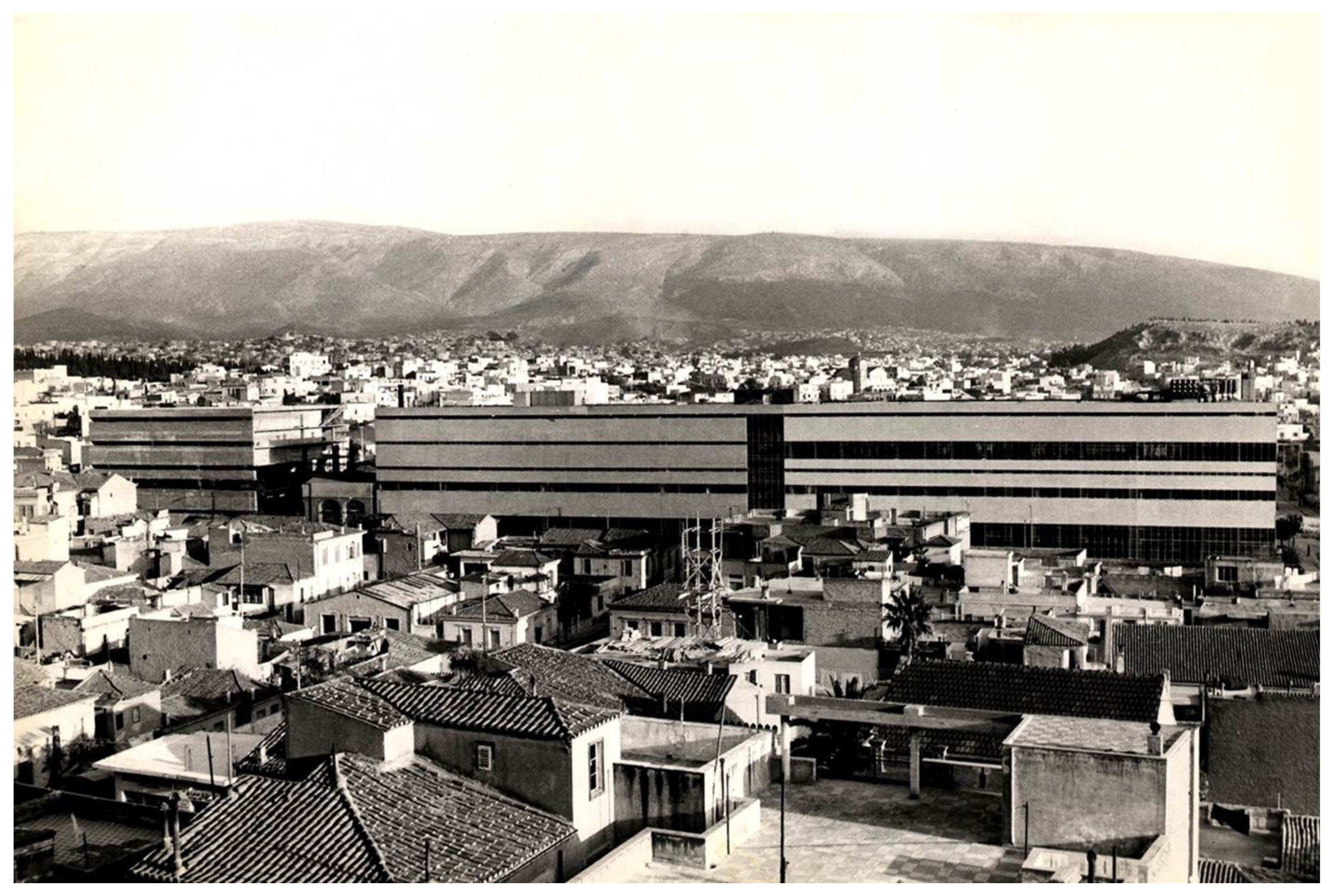

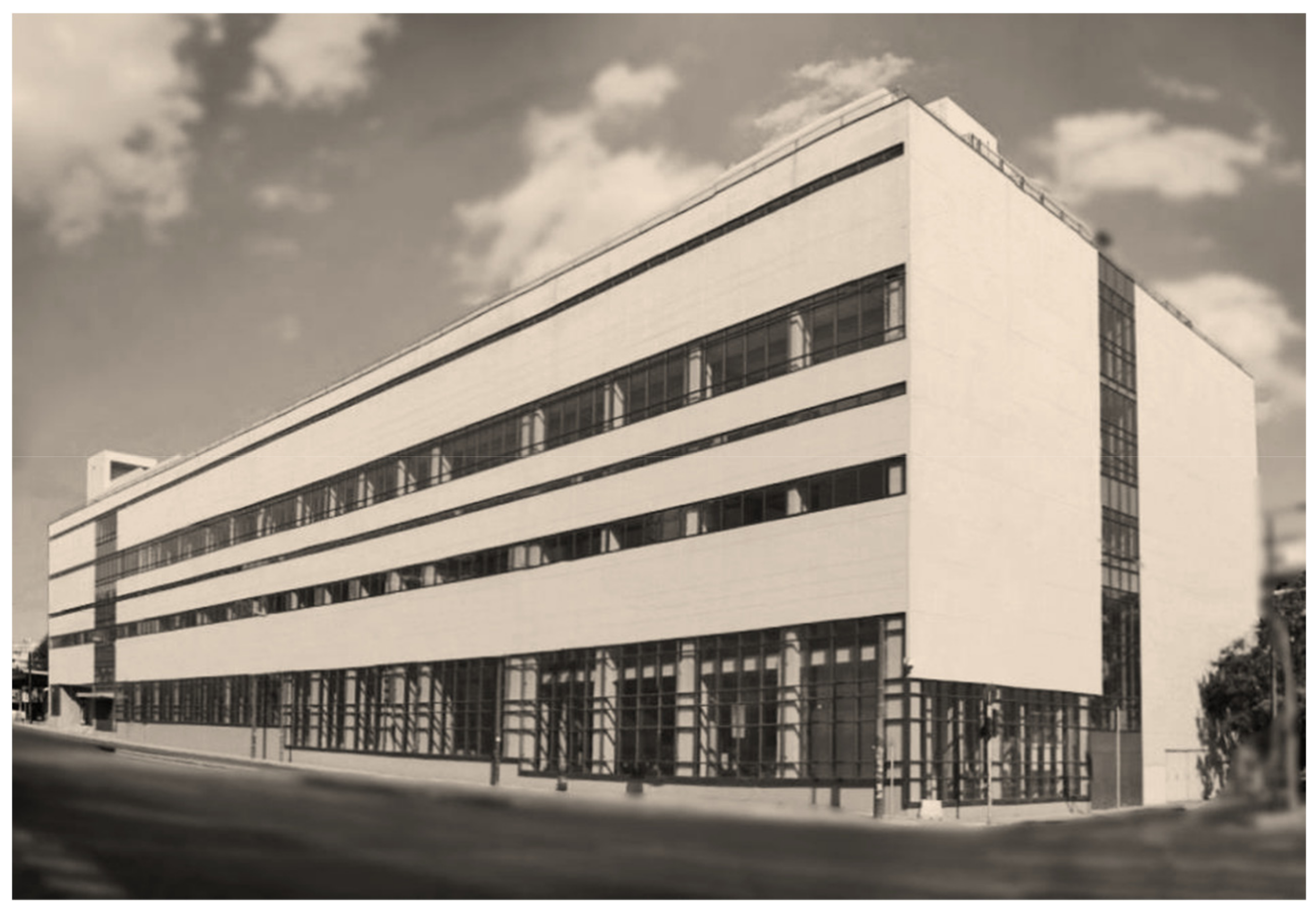
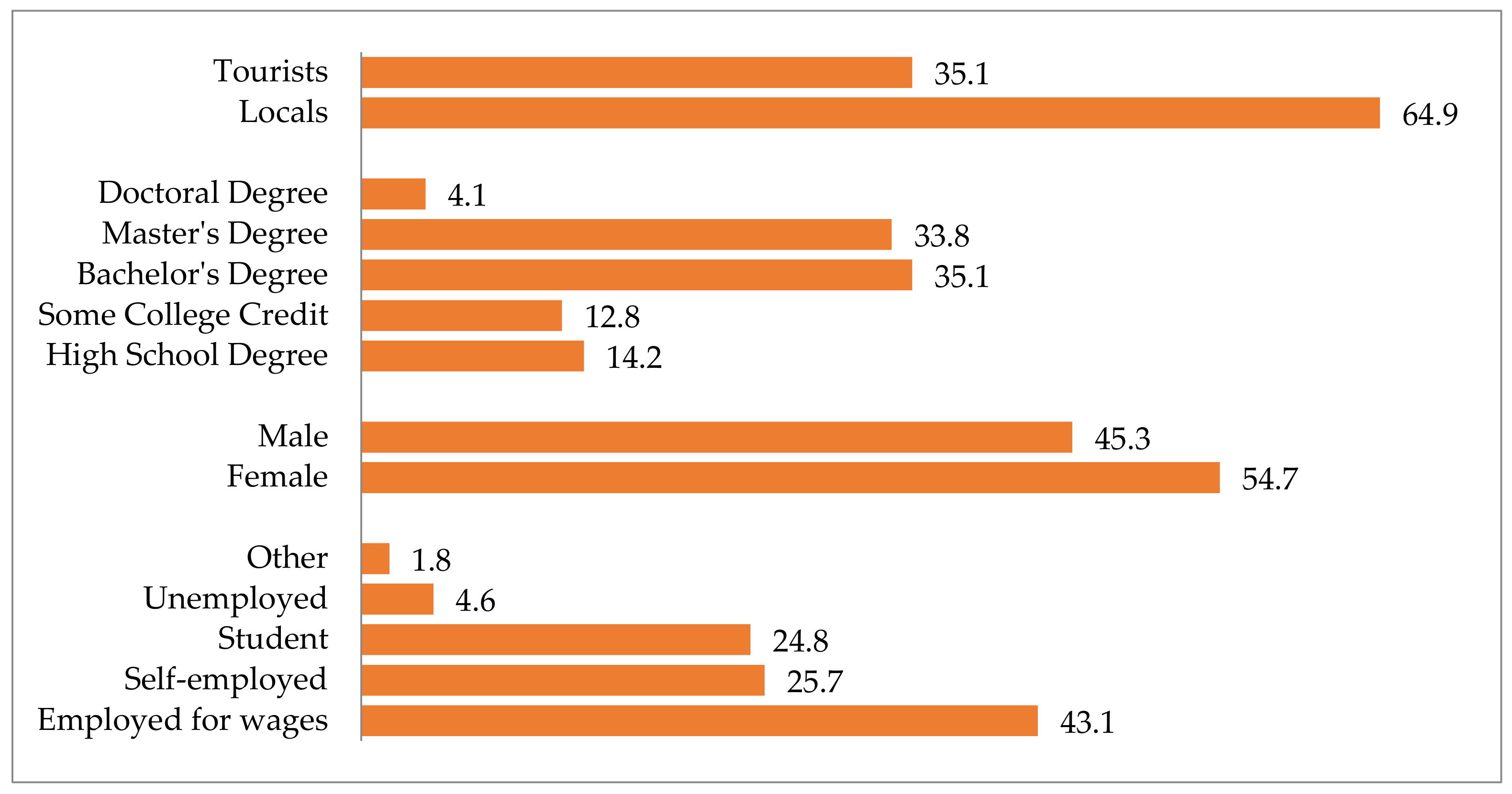



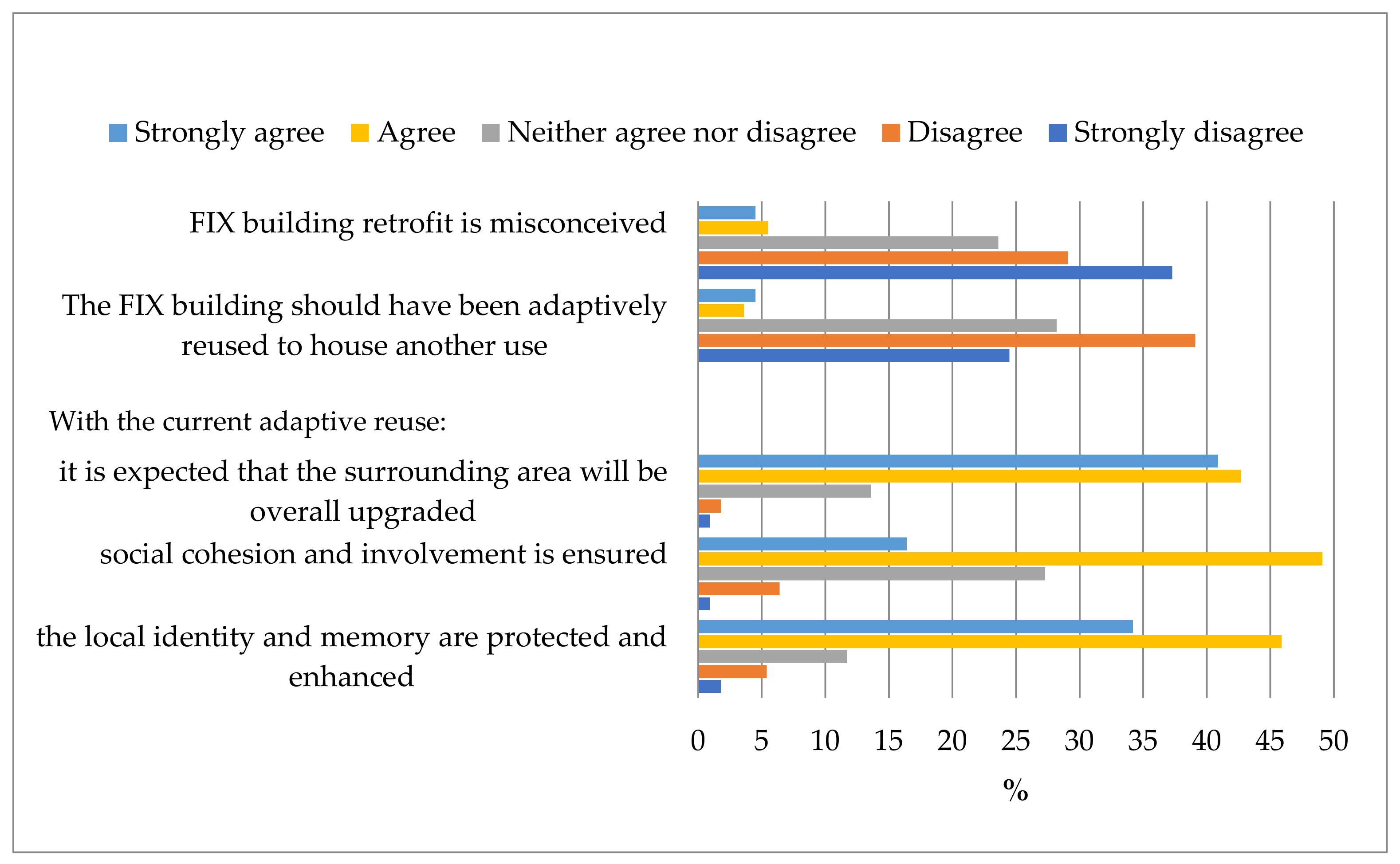
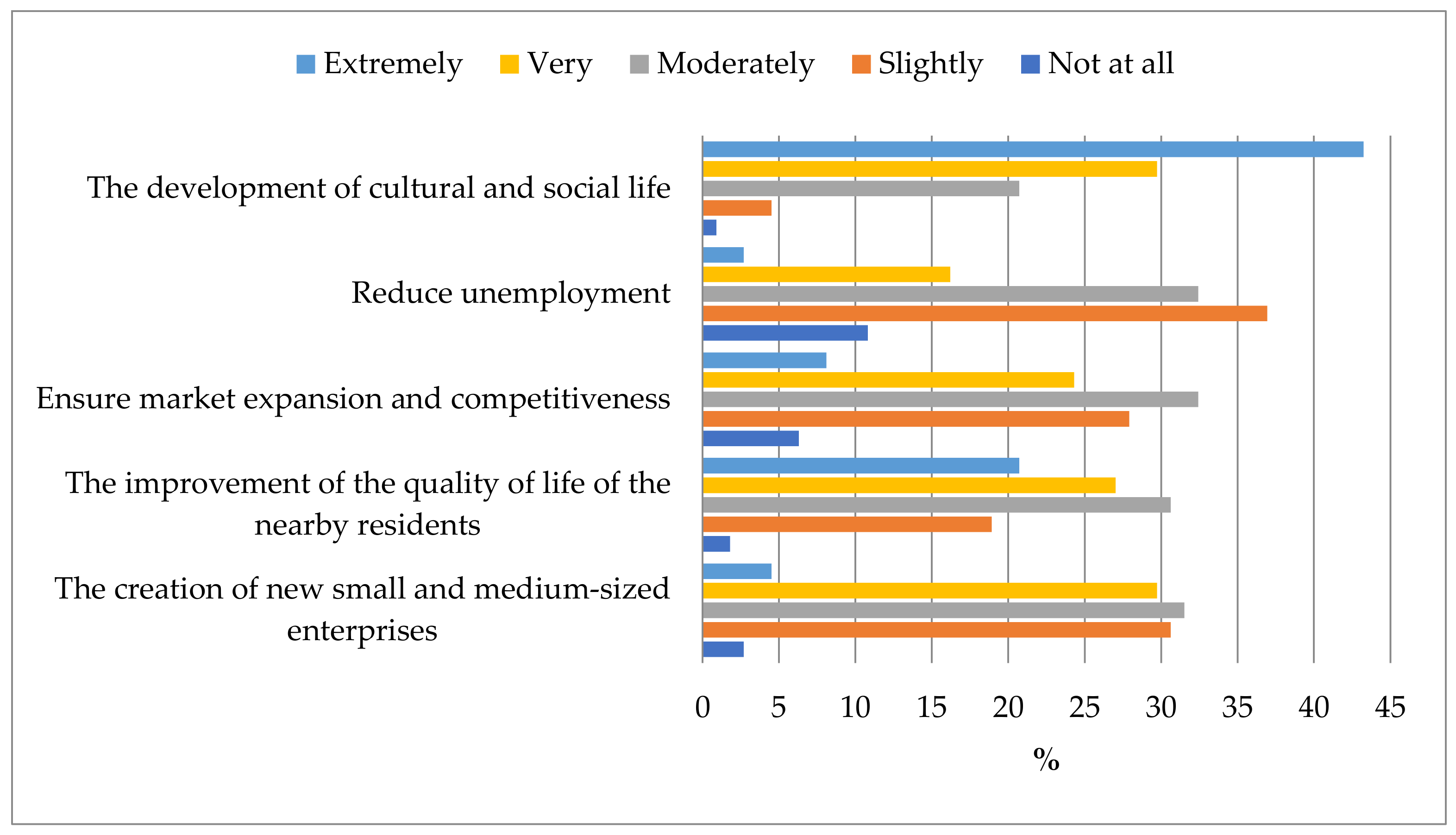
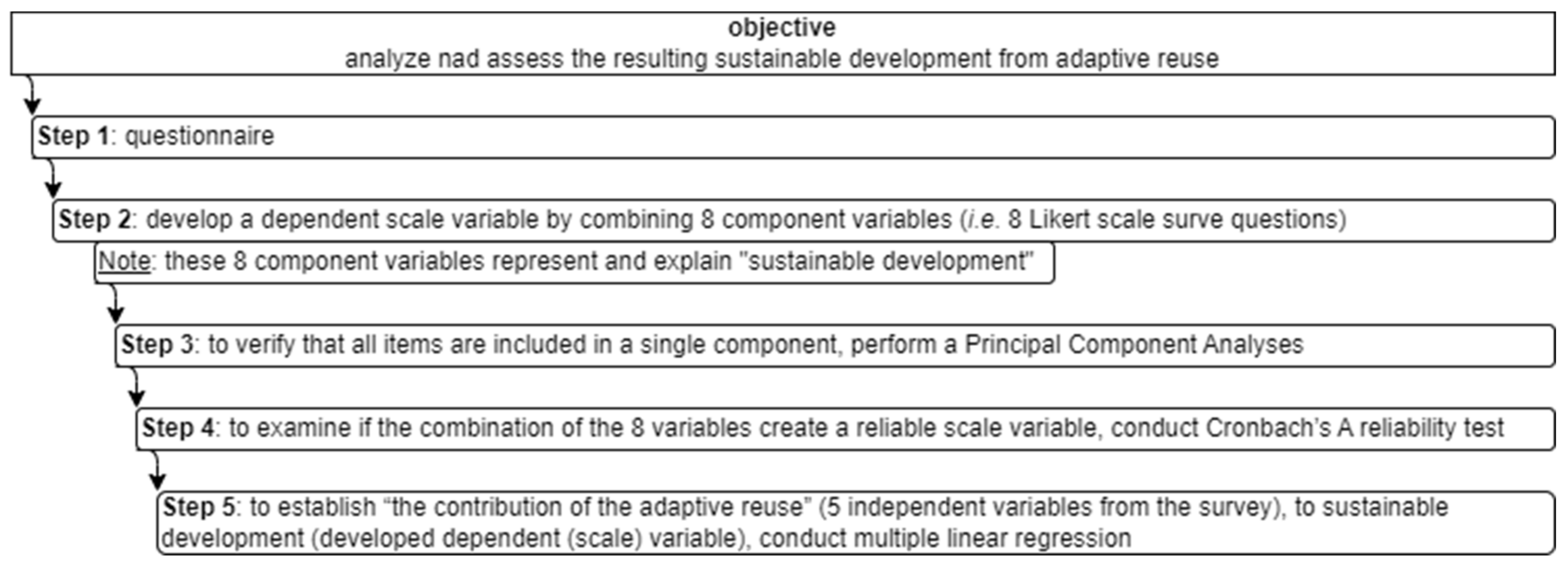
| Coded Variable | Variable |
|---|---|
| ENVRON | To what extent do you consider the adaptive reuse of the FIX Brewery building to be environmentally friendly? |
| SMEs | The adaptive reuse of the FIX Brewery building to house the Hellenic National Museum of Contemporary Art contributes to the creation of new small and medium-sized enterprises. |
| LIFEQUALITY | The adaptive reuse of the FIX Brewery building to house the Hellenic National Museum of Contemporary Art contributes to the improvement of the quality of life of the nearby residents. |
| INCOMERAISE | The adaptive reuse of the FIX Brewery building to house the Hellenic National Museum of Contemporary Art contributes to raising the incomes of the nearby residents and professionals. |
| TOURISMCENTER | The adaptive reuse of the FIX Brewery building to house the Hellenic National Museum of Contemporary Art contributes to the strengthening and establishment of the city as a visitor/tourist attraction. |
| MARKET | The adaptive reuse of the FIX Brewery building to house the Hellenic National Museum of Contemporary Art contributes to ensuring market expansion and competitiveness. |
| UNEMPLOYMENT | The adaptive reuse of the FIX Brewery building to house the Hellenic National Museum of Contemporary Art contributes to reducing unemployment. |
| CULTURALADVANCEMENT | The adaptive reuse of the FIX Brewery building to house the Hellenic National Museum of Contemporary Art contributes to the development of cultural and social life. |
| Model | Unstandardized Coefficients | Standardized Coefficients | t | Sig. | 95% Confidence Interval for B | ||
|---|---|---|---|---|---|---|---|
| B | Std. Error | Beta | Lower Bound | Upper Bound | |||
| (Constant) | 1.553 | 0.349 | 4.454 | 0.000 | 0.864 | 2.243 | |
| TOURATRACTION | 0.186 | 0.063 | 0.220 | 2.935 | 0.004 | 0.061 | 0.310 |
| NEXTVISIT | 0.229 | 0.117 | 0.148 | 1.961 | 0.052 | −0.002 | 0.460 |
| SATISFA | 0.242 | 0.056 | 0.338 | 4.295 | 0.000 | 0.131 | 0.353 |
| HISTORYPERCEPTION | 0.082 | 0.038 | 0.155 | 2.147 | 0.034 | 0.007 | 0.158 |
| NATIONALITY | −0.439 | 0.150 | −0.212 | −2.934 | 0.004 | −0.735 | −0.143 |
| TOURATRACTION: Do you consider that museums in Greece are tourist attractions? NEXTVISIT: Was your visit to the Hellenic National Museum of Contemporary Art combined with a visit to another cultural recreational space? SATISFA: Overall, how satisfied or dissatisfied were you with your visit to the Hellenic National Museum of Contemporary Art? HISTORYPERCEPTION: Do you know the history of the FIX Brewery building that houses the Hellenic National Museum of Contemporary Art? NATIONALITY: What is your nationality? | |||||||
Disclaimer/Publisher’s Note: The statements, opinions and data contained in all publications are solely those of the individual author(s) and contributor(s) and not of MDPI and/or the editor(s). MDPI and/or the editor(s) disclaim responsibility for any injury to people or property resulting from any ideas, methods, instructions or products referred to in the content. |
© 2023 by the author. Licensee MDPI, Basel, Switzerland. This article is an open access article distributed under the terms and conditions of the Creative Commons Attribution (CC BY) license (https://creativecommons.org/licenses/by/4.0/).
Share and Cite
Vardopoulos, I. Adaptive Reuse for Sustainable Development and Land Use: A Multivariate Linear Regression Analysis Estimating Key Determinants of Public Perceptions. Heritage 2023, 6, 809-828. https://doi.org/10.3390/heritage6020045
Vardopoulos I. Adaptive Reuse for Sustainable Development and Land Use: A Multivariate Linear Regression Analysis Estimating Key Determinants of Public Perceptions. Heritage. 2023; 6(2):809-828. https://doi.org/10.3390/heritage6020045
Chicago/Turabian StyleVardopoulos, Ioannis. 2023. "Adaptive Reuse for Sustainable Development and Land Use: A Multivariate Linear Regression Analysis Estimating Key Determinants of Public Perceptions" Heritage 6, no. 2: 809-828. https://doi.org/10.3390/heritage6020045
APA StyleVardopoulos, I. (2023). Adaptive Reuse for Sustainable Development and Land Use: A Multivariate Linear Regression Analysis Estimating Key Determinants of Public Perceptions. Heritage, 6(2), 809-828. https://doi.org/10.3390/heritage6020045






